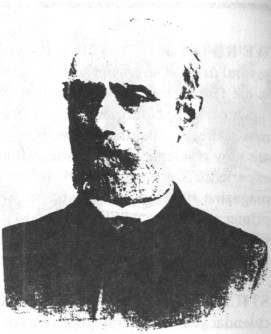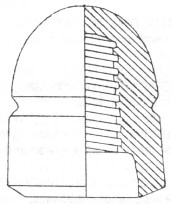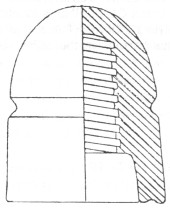The Harvey Prentice Dwight Story
by Eric Halpin
Reprinted from "Crown Jewels of the Wire", January 1989, page 4
When I was preparing the article on Withycomb and his ridged insulators
(August, 1987 Crown Jewels), I could find plenty of insulator patent material to
discuss, but little on the man himself. This Dwight story is much the opposite,
with more information on Mr. Dwight being available but little on the insulators
on which his name appears.
Harvey Prentice Dwight was born in the village of Belleville, Jefferson
County, New York on December23, 1828. At 14 years of age, he left local school
to seek his fortune, and like many young men of the day, he took to the magic of
the telegraph. Drifting eventually to Belleville, Ontario, he began working as a
telegrapher until 1847 when he moved to Montreal, Quebec, and became chief
operator for the recently formed Montreal Telegraph Company. By 1850, he was
transferred to Toronto to take charge of M.T.CO.'s office there, and in 1865 he
became their western superintendent. After the Great Northwestern Telegraph
Company amalgamated with the Montreal Telegraph Company under the G.N.W.
charter in 1881, Mr. Dwight became the general manager. In 1892, Mr. Dwight rose
to the presidency of G.N.W. but also continued his role as general manager until
1903.

Mr. Dwight was a very energetic and highly respected businessman who
continued to act as consultant and director of various businesses. He was the
1st vice president of the Canadian General Electric Co., vice president of the
London Electric Light Co., and a director of the Toronto Electric Light Company
at the time of his death in 1912 in his 84th year. The book, CANADIAN MEN AND
WOMEN OF THE TIME, by Morgan (1912) states... "nobody like him. An able, experienced and upright business manager. Doubly gifted with a
keen scientific instinct on the one hand and a rare business capacity on the
other." The CYCLOPEDIA OF CANADIAN BIOGRAPHY, Volume 1, by Rose (1886) says
that... "under his direction, telegraph lines have been laid in every
portion of the country where roads made it practical to establish them."
Obviously Mr. Dwight was quite a man, and Canada was fortunate to have been the
recipient of his many talents.
Is there a collector out there who hasn't seen a CD 143 embossed 'DWIGHT! PATTERN"? These insulators were made by the millions, and most of them are
quite common insulators within the hobby today. In fact, some of these insulators
can still be seen on the poles. There are two basic styles of CD 143 Dwight
insulators. One of these is often called the "short-boy" Dwight (Figure
1). This style has an outside beveled skirt face extending from the base
to about 1/2" up the skirt side. The reason for the "short-boy"
nametag is that when the insulator was removed from the mold and put right side
up on the base, there was a tendency for the insulator to sag slightly while on
this narrow base. Thus, compared to the other Dwight style, they are often a
bit shorter. The beveled skirt to the base idea really represents for all
practical purposes, one continuous drip point to shed water.
The second Dwight style is more often recognized by the grooved base (Figure
2). This groove, or really an indentation, runs in the center of the base and
results in a not very prominent double continuous drip ring. Of the many dozens
of mold styles available in the CD 143's, there are only four insulators with
any apparent intentional drip ring design. They are the ridged base M.T.CO.,
the grooved base G.N.W. and both styles of Dwights. It is quite plausible that
Mr. Dwight is the common thread between these four designs and two companies.
|

FIGURE 1 represents the beveled skirt
to base variety. This insulator is found in four main embossing variants as
follows:
a.) G.N.W. DWIGHT/PATTERN: a very scarce embossing found in color tones
of aqua
b.) (blotted out G.N.W.) DWIGHT/PATTERN: a common embossing found in
color tones of aqua, green, steel blue, near clear, and numerous shades of SCA.
c.) (blotted out G.N.W.) _DWIGHT/PATTERN: a common embossing found in color
tones of aqua, green and near clear.
d.) DWIGHT/PATTERN: a common embossing
found in color tones of aqua, green and SCA. |
|

FIGURE 2. represents the grooved base variety. This
insulator is also found in four main embossing variants as follows:
a.) G.N.W. DWIGHT/PATTERN: a very scarce embossing found
in color tones of aqua.
b.) (blotted out G.N.W.) . . . DWIGHT/PATTERN: a common
embossing found in color tones of aqua.
c.) (blotted out G.N.W.) _DWIGHT/ PATTERN: a common
embossing found in color tones of aqua, green and light blue.
d.) (blotted out G.N.W.) DWIGHT/PATTERN: a common
embossing found in color tones of aqua.
|
The latter three examples are also characterized by a crown top backward 2.
Note that in all examples the DWIGHT and PATTERN are off skirt center. Even
after the G.N.W. reference was removed, the DWIGHT was never repositioned.
Detailed examination of the embossing reveals subtle differences between the
insulators of the same variety. Thus, at least two molds were used, even in the
scarce G.N.W. DWIGHT variety.
There is a porcelain insulator, the U-1131, that has an incused GISBORNE
PATTERN on it. Mr. Gisborne (1824-1892) secured six different telephone and
telegraph patents between 1884 and 1886, but none on an insulator. The base of
the GISBORNE is identical to the style #2 DWIGHT in that a slight indentation
runs in the center of the base forming two drip rings. For all intents and
purposes, the DWIGHT/PATTERN and GISBORNE/PATTERN insulators are the very same
except for material. I am sure there is a connection between the two, but at
this point in time I am unable to identity it. Mr. Dwight also never secured any
type of insulator patent.
It has generally been assumed that the G.N.W. was blotted out in the mold
shortly after the company was absorbed into the Canadian Northern network around
1915. However, full turnover didn't occur overnight, and G.N.W. telegraphs
continued to function until at least 1919. Since Mr. Dwight died in 1912, I am
unable to comprehend why these insulators were seemingly produced years after
his death. In fact, I believe that both insulator varieties were produced
simultaneously while he was alive and in charge of the company, but now I can't
account for why the G.N.W. was blotted out.
The overall quality of the insulators is good with defects seldom ever being
found. They were used from coast to coast in Canada on C.N.R. lines, and in some
cases they were also used in the U.S.A. where C.N.R. lines continued into the
states. Even though the wire grooves appear to be somewhat shallow, these
insulators continue to withstand the test of time. Mr. Dwight can be proud of
his insulators.
|
